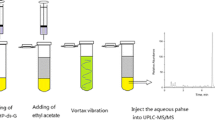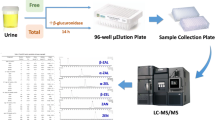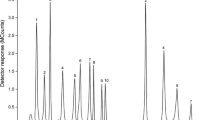Abstract
A simple and sensitive method for analysis of 1-OHP-G in urine to evaluate PAHs exposure was established. The urine was extracted with a OASIS PRiME HLB column, and the eluent was directly injected into HPLC–FLD for analysis. The separation was carried out on a ACQUIIY UPLC BEH C18 column (2.1 × 50 mm, 1.7 μm), using methanol–1.5% formic acid water (60:40, v:v) as mobile phase at the flow rate of 0.2 mL/min. 1-OHP-G was detected at the excitation wavelength of 338 nm and the emission wavelength of 379 nm. Good linearity was obtained from 0.010 to 5.0 ng/mL for 1-OHP-G. The limit of detection of 1-OHP-G was 0.0032 ng/mL and the limit of quantification was 0.010 ng/mL. The intra-day and the inter-day precisions were 1.68, 4.98 and 1.81%, 5.00% at the concentrations of 0.010 ng/mL and 5.0 ng/mL, respectively. The proposed method was applied for urine sample analysis and the whole procedure could be completed within 8 min with the recoveries of 91.9–109%, 92.7–107% and 94.5–107% at the concentrations of 0.010 ng/mL, 1.0 ng/mL and 5.0 ng/mL, respectively. The results of 41 urine samples from non-professionals measured with the proposed method and UPLC–MS/MS were compared by Bland–Altman test and Passing–Bablok regression, showing a good agreement between the two methods. Moreover, dynamic change of urinary 1-OHP-G after eating barbecued food was detected by the proposed method and the results were consistent with the reported researches about 1-OHP. The proposed method was simple and rapid, and it could also to meet the assessment of population exposure to PAHs with high sensitivity and accuracy.
Graphical Abstract





Similar content being viewed by others
References
Jongeneelen FJ (1994) Biological monitoring of environmental exposure to polycyclic aromatic hydrocarbons; 1-hydroxypyrene in urine of people. Toxicol Lett 72(1–3):205–211
Srogi K (2007) Monitoring of environmental exposure to polycyclic aromatic hydrocarbons: a review. Environ Chem Lett 5(4):169–195. https://doi.org/10.1007/s10311-007-0095-0
de Oliveira BF, Chacra AP, Frauches TS, Vallochi A, Hacon S (2014) A curated review of recent literature of biomarkers used for assessing air pollution exposures and effects in humans. J Toxicol Environ Health Part B Crit Rev 17(7–8):369–410. https://doi.org/10.1080/10937404.2014.976893
Strickland P, Kang D, Sithisarankul P (1996) Polycyclic aromatic hydrocarbon metabolites in urine as biomarkers of exposure and effect. Environ Health Persp 104(Suppl 5):927–932. https://doi.org/10.2307/3433012
Castano-Vinyals G, D’Errico A, Malats N, Kogevinas M (2004) Biomarkers of exposure to polycyclic aromatic hydrocarbons from environmental air pollution. Occup Environ Med 61(4):e12
Kim KH, Jahan SA, Kabir E, Brown RJ (2013) A review of airborne polycyclic aromatic hydrocarbons (PAHs) and their human health effects. Environ Int 60:71–80. https://doi.org/10.1016/j.envint.2013.07.019
Lai C-H (2012) Exposure to polycyclic aromatic hydrocarbons associated with traffic exhaust: the increase of lipid peroxidation and reduction of antioxidant capacity. Aerosol Air Qual Res 15:12. https://doi.org/10.4209/aaqr.2012.01.0021
Strickland P, Kang DH (1999) Urinary 1-hydroxypyrene and other PAH metabolites as biomarkers of exposure to environmental PAH in air particulate matter. Toxicol Lett 108(2–3):191–199. https://doi.org/10.1016/S0378-4274(99)00089-2
Tairova ZM, Giessing AM, Hansen R, Andersen O (2009) 1-Hydroxypyrene as a biomarker of PAH exposure in the marine polychaete Nereis diversicolor. Mar Environ Res 67(1):38–46. https://doi.org/10.1016/j.marenvres.2008.10.005
Huang HB, Lai CH, Chen GW, Lin YY, Jaakkola JJ, Liou SH, Wang SL (2012) Traffic-related air pollution and DNA damage: a longitudinal study in Taiwanese traffic conductors. PLoS ONE 7(5):e37412. https://doi.org/10.1371/journal.pone.0037412
Strickland PT, Kang D, Bowman ED, Fitzwilliam A, Downing TE, Rothman N, Groopman JD, Weston A (1994) Identification of 1-hydroxypyrene glucuronide as a major pyrene metabolite in human urine by synchronous fluorescence spectroscopy and gas-chromatography mass-spectrometry. Carcinogenesis 15(3):483–487. https://doi.org/10.1093/carcin/15.3.483
Liao LM, Hofmann JN, Kamangar F, Strickland PT, Ji BT, Yang G, Li HL, Rothman N, Zheng W, Chow WH, Gao YT, Shu XO (2014) Polycyclic aromatic hydrocarbons and risk of gastric cancer in the Shanghai Women’s Health Study. Int J Mol Epidemiol Genet 5(3):140–144
Singh R, Tucek M, Maxa K, Tenglerova J, Weyand EH (1995) A rapid and simple method for the analysis of 1-hydroxypyrene glucuronide: a potential biomarker for polycyclic aromatic hydrocarbon exposure. Carcinogenesis 16(12):2909–2915
Lee CK, Cho SH, Kang JW, Lee SJ, Ju YS, Sung J, Strickland PT, Kang D (1999) Comparison of three analytical methods for 1-hydroxypyrene glucuronide in urine after non-occupational exposure to polycyclic aromatic hydrocarbons. Toxicol Lett 108(2–3):209–215
Peters KO, Williams AL, Abubaker S, Curtin-Brosnan J, McCormack MC, Peng R, Breysse PN, Matsui EC, Hansel NN, Diette GB, Strickland PT (2017) Predictors of polycyclic aromatic hydrocarbon exposure and internal dose in inner city Baltimore children. J Exposure Sci Environ Epidemiol 27(3):290–298. https://doi.org/10.1038/jes.2016.57
Yoon HS, Lee KM, Lee KH, Kim S, Choi K, Kang D (2012) Polycyclic aromatic hydrocarbon (1-OHPG and 2-naphthol) and oxidative stress (malondialdehyde) biomarkers in urine among Korean adults and children. Int J Hyg Environ Health 215(4):458–464. https://doi.org/10.1016/j.ijheh.2012.02.007
Moon KA, Rule AM, Magid HS, Ferguson JM, Susan J, Sun Z, Torrey C, Abubaker S, Levshin V, Carkoglu A, Radwan GN, El-Rabbat M, Cohen JE, Strickland P, Breysse PN, Navas-Acien A (2018) Biomarkers of secondhand smoke exposure in waterpipe tobacco venue employees in Istanbul, Moscow, and Cairo. Nicotine Tob Res 20(4):482–491. https://doi.org/10.1093/ntr/ntx125
Miao Q, Bouchard M, Chen D, Burstyn I, Spinelli JJ, Aronson KJ (2014) Assessing traffic and polycyclic aromatic hydrocarbon exposure in Montreal, Canada. Sci Total Environ 470–471:945–953. https://doi.org/10.1016/j.scitotenv.2013.10.030
Kakimoto K, Toriba A, Ohno T, Ueno M, Kameda T, Tang N, Hayakawa K (2008) Direct measurement of the glucuronide conjugate of 1-hydroxypyrene in human urine by using liquid chromatography with tandem mass spectrometry. J Chromatogr B Anal Technol Biomed Life Sci 867(2):259–263. https://doi.org/10.1016/j.jchromb.2008.04.015
Li M, Wang Q, Zhu J, Li N, Zou X (2017) A simple analytical method of determining 1-hydroxypyrene glucuronide in human urine by isotope dilution with ultra performance liquid chromatography-tandem mass spectrometry. Anal Bioanal Chem 409(6):1513–1518. https://doi.org/10.1007/s00216-016-0083-y
Cao M, Liu Y, Huang Z, Zhou L, Wang X (2009) Simultaneous detection of the level of free 1-hydropyrene and 1-hydropyrene glucuronide in urine samples with high performance liquid chromatography mass spectrometry. China Occup Med 36:109–111
Wilson RA, Seliskar CJ, Talaska G, Heineman WR (2011) Spectroelectrochemical sensing of pyrene metabolites 1-hydroxypyrene and 1-hydroxypyrene-glucuronide. Anal Chem 83:3725–3729
Buckley TJ, Lioy PJ (1992) An examination of the time course from human dietary exposure to polycyclic aromatic hydrocarbons to urinary elimination of 1-hydroxypyrene. Br J Ind Med 49(2):113–124
Chien YC, Yeh CT (2010) Amounts and proportion of administered pyrene dose excreted as urinary 1-hydroxypyrene after dietary exposure to polycyclic aromatic hydrocarbons. Arch Toxicol 84(10):767–776. https://doi.org/10.1007/s00204-010-0570-4
Acknowledgements
We would like to thank the Public Health and Preventive Medicine Provincial Experiment Teaching Center at Sichuan University and Food Safety Monitoring and Risk Assessment Key Laboratory of Sichuan Province for providing the experimental platform.
Funding
This study was supported by grants from the National Key Technologies R&D Program of Ministry of Science and Technology of China (ID: 2017YFC1600206) and the Natural Science Foundation of China (IDs: 81573165, 81602865)
Author information
Authors and Affiliations
Corresponding author
Ethics declarations
Conflict of interest
All authors declare that they have no conflict of interest to declare.
Ethical Approval
All experiments were performed in compliance with the relevant Chinese laws and with the 1964 Helsinki Declaration and its later amendments or comparable ethical standards and the whole study was approved by the medical ethics committee of West China Second University Hospital, Sichuan University. Human urine samples, used for the development, validation of the method and dynamic change research, were obtained from healthy donors in West China Second University Hospital, Sichuan University, after their informed consent, and then stored at − 80 °C until analysis.
Additional information
Publisher's Note
Springer Nature remains neutral with regard to jurisdictional claims in published maps and institutional affiliations.
Rights and permissions
About this article
Cite this article
Yang, M., Wang, Y., Ren, J. et al. A Rapid and Sensitive Method of Determination of 1-Hydroxypyrene Glucuronide in Urine by UPLC–FLD. Chromatographia 82, 835–842 (2019). https://doi.org/10.1007/s10337-019-03713-0
Received:
Revised:
Accepted:
Published:
Issue Date:
DOI: https://doi.org/10.1007/s10337-019-03713-0




